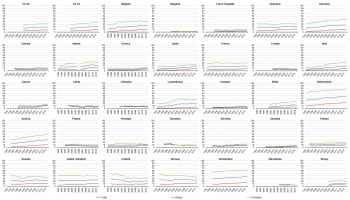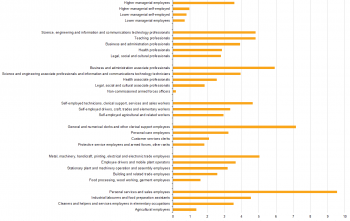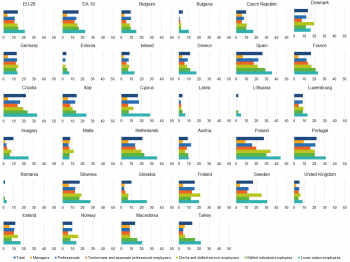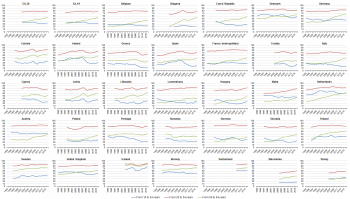Archive:Employment statistics
- Data from November 2016. Most recent data: Further Eurostat information, Main tables and Database. Planned article update: June 2017.
This article presents recent European Union (EU) employment statistics, including an analysis based on socioeconomic dimensions: employment statistics show considerable differences by sex, age and educational level attained. There are also considerable labour market disparities across EU Member States.
Labour market statistics are at the heart of many EU policies following the introduction of an employment chapter into the Amsterdam Treaty in 1997. The employment rate, in other words the proportion of the working age population that is in employment, is considered to be a key social indicator for analytical purposes when studying developments within labour markets.

(%)
Source: Eurostat (lfsa_ergaed)

(%)
Source: Eurostat (lfsa_eppga)

(% of total employment)
Source: Eurostat (lfsa_e2ged) and (lfsa_egaed)

(% of total employment)
Source: Eurostat (lfsa_esegp)

(% of occupational group)
Source: Eurostat (lfsa_esegt)
Main statistical findings
Employment rates by sex, age and educational attainment
In 2015, the EU-28 employment rate for persons aged 20 to 64, as measured by the EU’s labour force survey (EU LFS), stood at 70.1 %. The EU-28 employment rate peaked in 2008 at 70.3 % and decreased during successive years to stand at 68.4 % in 2012 and 2013. This fall during the global financial and economic crisis and its aftermath resulted in an overall reduction of 1.9 percentage points. There followed a return to the upward path observed prior to the crisis, with increases for the EU-28 employment rate of 0.8 and 0.9 percentage points in 2014 and 2015 to reach 70.1 % in 2015, just 0.2 percentage points below the pre-crisis peak (see Table 1).
Among the EU Member States, employment rates in 2015 were within the range of 76 % to 77 % in the Netherlands, Estonia, Denmark and the United Kingdom, reaching 78.0 % in Germany and peaked at 80.5 % in Sweden. At the other end of the scale, employment rates were below 65 % in four of the EU-28 Member States, with the lowest rate — 54.9 % — being recorded in Greece (see Figure 1).
Between the start of the financial and economic crisis and 2015 (the latest data available), there were considerable differences in the performances of the individual labour markets. While the overall employment rate for the EU-28 in 2015 had nearly returned to its peak level of 2008, there were 11 EU Member States which reported an increase in their respective rates. The biggest gains were recorded in Malta (up 8.6 percentage points), Hungary (7.4 points) and Germany (4.0 points). By contrast, the Greek employment rate fell from 66.3 % in 2008 to 52.9 % in 2013 before recovering to 54.9 % in 2015, an overall fall of 11.4 percentage points. There were also considerable reductions between 2008 and 2015 for the employment rates of Cyprus (-8.6 points) and Spain (-6.5 points).
Employment rates are generally lower among women and older workers. In 2015, the employment rate for men aged 20–64 stood at 75.9 % in the EU-28, as compared with 64.3 % for women. A longer-term comparison shows that while the employment rate for men in 2015 was the same as 10 years earlier (75.9 % in 2005), there was a marked increase in the proportion of women in employment — rising 4.3 percentage points from 60.0 % in 2005 (see Table 2).
Male employment rates were consistently higher than those for women across all of the EU-28 Member States in 2015, although there were considerable disparities. The difference between employment rates by sex was as wide as 27.8 percentage points in Malta, where the third lowest female employment rate (53.6 %) was recorded. Italy, Greece, Romania and the Czech Republic reported gender gaps of 16.6–20.0 percentage points; for Greece, Italy and Romania this reflected the fact that they reported the lowest, second lowest and sixth lowest female employment rates; the large gender gap in the Czech Republic reflected a particularly high male employment rate (83.0 %, the highest among the EU Member States), rather than a low female employment rate. There was very little difference in employment rates between the sexes in Finland and Lithuania, where female rates were less than 2.5 percentage points lower than those for men. Gender differences for employment rates were also relatively small in Latvia and Sweden.
Among the non-member countries shown in Table 2, Turkey recorded by far the largest gender difference in employment rates, the 32.5 % rate for women being 42.8 percentage points below the equivalent rate for men. The former Yugoslav Republic of Macedonia also reported relatively large differences between the sexes. Norway (4.6 %) and Iceland (6.3 %) both had relatively small gender differences in employment rates (see Figure 2).
As with the female employment rate, there was evidence that the employment rate of older workers (aged between 55 and 64) increased at a rapid pace despite the financial and economic crisis. For the EU-28, the employment rate of older workers reached 53.3 % in 2015; the rate increased every year from 2002 (the start of the time series for the EU-28) up to and including 2015 (the latest information available). In 2015, there were 11 EU-28 Member States that had employment rates for older workers that were between 50 % and 66 %, while by far the highest rate was recorded in Sweden at 74.5 % (see Table 2). The three EFTA countries for which data are available also recorded high employment rates for older workers, each over 70 %, peaking at 84.8 % in Iceland. A more detailed analysis of employment rates by age group is provided in Figure 3 — which confirms that the highest employment rates were consistently recorded among those aged 25 to 54.
Employment rates also vary considerably according to the level of educational attainment. Like the other analysis of employment rates in this article, the rates analysed by level of educational attainment are also based on the age group 20 to 64. It should be noted that the younger members of this age group may still be in education, particularly in tertiary education, and this may be reflected in the employment rates.
The employment rate of those who had completed a tertiary (short-cycle tertiary, bachelor’s, master’s or doctoral levels (or equivalents)) education was 82.7 % across the EU-28 in 2015 (see Table 3), much higher than the rate (52.6 %) for those who had attained no more than a primary or lower secondary education. The EU-28 employment rate of persons with at most an upper secondary or post-secondary non-tertiary education was 70.7 %. The largest falls in employment rates since the beginning of the financial and economic crisis (comparing 2008 with 2015) were witnessed for persons with at most a primary or lower secondary education (down 3.8 percentage points), while notably smaller falls were observed for persons with a tertiary education and persons with at most an upper secondary or post-secondary non-tertiary education (both down 1.1 percentage points).
Part-time and fixed-term contracts
The proportion of the EU-28 workforce in the age group 20–64 years reporting that their main job was part-time increased steadily from 16.5 % in 2005 to 19.0 % by 2015. By far the highest proportion of part-time workers in 2015 was found in the Netherlands (46.9 %), followed by Austria, Germany, Belgium, the United Kingdom, Sweden, Ireland and Denmark, where part-time work accounted in each case for more than a fifth of those in employment. By contrast, part-time employment was relatively uncommon in Bulgaria (2.2 % of those in employment) as well as the Czech Republic, Slovakia, Hungary and Croatia (between 5.2 % and 5.9 %) — see Table 4.
The incidence of part-time work (see Data sources and availability for definition) differs significantly between men and women. Just under one third (31.5 %) of women aged 20–64 who were employed in the EU-28 worked on a part-time basis in 2015, a much higher proportion than the corresponding share for men (8.2 %). More than three quarters (75.3 %) of women employed in the Netherlands worked on a part-time basis in 2015, by far the highest rate among the EU Member States.
In 2015, the proportion of employees aged 20–64 in the EU-28 with a contract of limited duration (fixed-term employment) was 11.1 %. More than one in five employees in Poland (21.9 %) and Spain (20.7 %) had a temporary contract— see Figure 5. Among the remaining EU-28 Member States, the share of employees working on a contract of limited duration ranged from 18.3 % in Portugal down to 1.8 % in Lithuania and 1.0 % in Romania. The considerable range in the propensity to use limited duration contracts between EU Member States may, at least to some degree, reflect national practices, the supply and demand of labour, employer assessments regarding potential growth/contraction, and the ease with which employers can hire or fire.
Data sources and availability
Coverage
The economically active population (labour force) comprises employed and unemployed persons. The EU LFS defines persons in employment as those aged 15 and over, who, during the reference week, performed some work, even for just one hour per week, for pay, profit or family gain. The labour force also includes people who were not at work but had a job or business from which they were temporarily absent, for example, because of illness, holidays, industrial disputes, education or training.
Employment can be measured in terms of the number of persons or jobs, in full-time equivalents or in hours worked. All the estimates presented in this article use the number of persons; the information presented for employment rates is also built on estimates for the number of persons. Employment statistics are frequently reported as employment rates to discount the changing size of countries’ populations over time and to facilitate comparisons between countries of different sizes. These rates are typically published for the working age population, which is generally considered to be those aged between 15 and 64 years, although the age range of 16 to 64 is used in Spain and the United Kingdom, as well as in Iceland. The 15 to 64 years age range is also a standard used by other international statistical organisations (although the age range of 20 to 64 years is given increasing prominence by some policymakers as a rising share of the EU population continue their studies into tertiary education).
Main concepts
Some main employment characteristics, as defined by the EU LFS, include:
- employees are defined as those who work for a public or private employer and who receive compensation in the form of wages, salaries, payment by results, or payment in kind; non-conscript members of the armed forces are also included;
- self-employed persons work in their own business, farm or professional practice. A self-employed person is considered to be working during the reference week if she/he meets one of the following criteria: works for the purpose of earning profit; spends time on the operation of a business; or is currently establishing a business;
- the distinction between full-time and part-time work is generally based on a spontaneous response by the respondent. The main exceptions are the Netherlands and Iceland where a 35 hours threshold is applied, Sweden where a threshold is applied to the self-employed, and Norway where persons working between 32 and 36 hours are asked whether this is a full- or part-time position;
- indicators for employed persons with a second job refer only to people with more than one job at the same time; people having changed job during the reference week are not counted as having two jobs;
- an employee is considered as having a temporary job if employer and employee agree that its end is determined by objective conditions, such as a specific date, the completion of an assignment, or the return of an employee who is temporarily replaced. Typical cases include: people in seasonal employment; people engaged by an agency or employment exchange and hired to a third party to perform a specific task (unless there is a written work contract of unlimited duration); people with specific training contracts.
Datasets
Most of the indicators presented in this article are from datasets that form part of the labour force survey main indicators (datasets starting with the letters lfsi). These main indicators differ from the datasets with the detailed annual and quarterly survey results (datasets starting with the letters lfsa and lfsq) in that the detailed survey results are exclusively based on microdata from the labour force survey, whereas the main indicators have received additional treatment. The most common additional adjustments are corrections of the main breaks in the series and estimations of missing values. These adjustments produce notable differences between the two data sets for some years.
The datasets of the labour force survey main indicators are the most complete and reliable collection of employment and unemployment data available from the labour force survey. However, as they do not offer analysis of all background variables, it is in some cases necessary to use the detailed survey results as well, as is done in this article for the data in Table 3 and part of Table 4.
Context
Employment statistics can be used for a number of different analyses, including macroeconomic (looking at labour as a production factor), productivity or competitiveness studies. They can also be used to study a range of social and behavioural aspects related to an individual’s employment situation, such as the social integration of minorities, or employment as a source of household income.
Employment is both a structural indicator and a short-term indicator. As a structural indicator, it may shed light on the structure of labour markets and economic systems, as measured through the balance of labour supply and demand, or the quality of employment. As a short-term indicator, employment follows the business cycle; however, it has limits in this respect, as employment is often referred to as a lagging indicator.
Employment statistics are at the heart of many EU policies. The European employment strategy (EES) was launched at the Luxembourg jobs summit in November 1997 and was revamped in 2005 to align the EU’s employment strategy more closely to a set of revised Lisbon objectives, and in July 2008, employment policy guidelines for the period 2008–2010 were updated. In March 2010, the European Commission launched the Europe 2020 strategy for smart, sustainable and inclusive growth; this was formally adopted by the European Council in June 2010. The European Council agreed on five headline targets, the first being to raise the employment rate for women and men aged 20 to 64 years old to 75 % by 2020. EU Member States may set their own national targets in the light of these headline targets and draw up national reform programmes that include the actions they aim to undertake in order to implement the strategy. The implementation of the strategy might be achieved, at least in part, through the promotion of flexible working conditions — for example, part-time work or work from home — which are thought to stimulate labour participation. Among others, initiatives that may encourage more people to enter the labour market include improvements in the availability of childcare facilities, providing more opportunities for lifelong learning, or facilitating job mobility. Central to this theme is the issue of ‘flexicurity’: policies that simultaneously address the flexibility of labour markets, work organisation and labour relations, while taking into account the reconciliation of work and private life, employment security and social protection. In line with the Europe 2020 strategy, the EES encourages measures to help meet three headline targets by 2020, namely, for:
- 75 % of people aged 20 to 64 to be in work;
- rates of early school leaving to reduce below 10 %, and for at least 40 % of 30 to 34-year-olds to have completed a tertiary education;
- at least 20 million fewer people to be in or at-risk-of-poverty and social exclusion.
The slow pace of recovery from the financial and economic crisis and mounting evidence of rising unemployment led the European Commission to make a set of proposals on 18 April 2012 for measures to boost jobs through a dedicated employment package. These proposals, among others, targeted the demand-side of job creation, setting out ways for EU Member States to encourage hiring by reducing taxes on labour or supporting business start-ups. The proposals also aimed to identify economic areas with the potential for considerable job creation, such as the green economy, health services and information and communications technology.
In December 2012, in the face of high and still rising youth unemployment in several EU Member States, the European Commission proposed a Youth employment package (COM(2012) 727 final). This package was a follow-up to the actions on youth laid out in the wider employment package and made a range of proposals, including:
- that all young people up to the age of 25 should receive a quality offer of a job, continued education, an apprenticeship or a traineeship within four months of leaving formal education or becoming unemployed (a youth guarantee);
- a consultation of European social partners on a quality framework for traineeships to enable young people to acquire high-quality work experience under safe conditions;
- a European alliance for apprenticeships to improve the quality and supply of apprenticeships available and outlining ways to reduce obstacles to mobility for young people.
Efforts to reduce youth unemployment continued in 2013 as the European Commission presented a Youth employment initiative (COM(2013) 144 final) designed to reinforce and accelerate measures outlined in the Youth employment package. It aimed to support, in particular, young people not in education, employment or training in regions with a youth unemployment rate above 25 %. There followed another Communication titled ‘Working together for Europe's young people – A call to action on youth unemployment' (COM(2013) 447 final) which was designed to accelerate the implementation of the youth guarantee and provide help to EU Member States and businesses so they may recruit more young people.
One of the main priorities of the College of Commissioners that entered into office in 2014 is to focus on boosting jobs, growth and investment, with the goal of cutting regulation, making smarter use of existing financial resources and public funds. In February 2015, the European Commission published a series of country reports, analysing the economic policies of EU Member States and providing information on EU Member States priorities for the coming year to boost growth and job creation. In the same month, the European Commission also proposed to make EUR 1 billion from the Youth employment initiative available in 2015 so as to increase by up to 30 times the pre-financing EU Member States could receive to boost youth employment rates, with the aim of helping up to 650 000 young people into work.
In June 2016, the European Commission adopted a Skills Agenda for Europe (COM(2016) 381/2) under the heading ‘Working together to strengthen human capital, employability and competitiveness’. This is intended to ensure that people develop the skills necessary for now and the future, in order to boost employability, competitiveness and growth across the EU.
See also
- European social statistics — online publication
- All articles on employment
- Job vacancy statistics
- Job vacancy trends
- Labour market and Labour force survey (LFS) statistics
- Labour market statistics introduced
- Labour market statistics at regional level
- Participation of young people in education and the labour market (background article)
- The EU in the world - labour market
- Underemployment and potential additional labour force statistics
- Youth unemployment (background article)
Further Eurostat information
Publications
- European social statistics, 2013 edition
- Labour market statistics, 2011
- Labour market statistics, 2010
- Reconciliation between work, private and family life in the European Union, 2009
- The social situation in the European Union, 2009
Main tables
- LFS main indicators (t_lfsi)
- Population, activity and inactivity - LFS adjusted series (t_lfsi_act)
- Employment - LFS adjusted series (t_lfsi_emp)
- Unemployment - LFS adjusted series (t_une)
- LFS series - Detailed annual survey results (t_lfsa)
- LFS series - Specific topics (t_lfst)
Database
- LFS main indicators (lfsi)
- Employment and activity - LFS adjusted series (lfsi_emp)
- Unemployment - LFS adjusted series (une)
- Labour market transitions - LFS longitudinal data (lfsi_long)
- LFS series - Detailed quarterly survey results (from 1998 onwards) (lfsq)
- LFS series - Detailed annual survey results (lfsa)
- LFS series - Specific topics (lfst)
- LFS ad-hoc modules (lfso)
- 2014. Migration and labour market (lfso_14)
- 2013. Accidents at work and other work-related health problems (lfso_13)
- 2012. Transition from work to retirement (lfso_12)
- 2011. Access to labour markets for disabled people (lfso_12)
- 2010. Reconciliation between work and family life (lfso_10)
- 2009. Entry of young people into the labour market (lfso_09)
- 2008. Labour market situation of migrants (lfso_08)
- 2007. Work related accidents, health problems and hazardous exposure (lfs_07)
- 2006. Transition from work into retirement (lfso_06)
- 2005. Reconciliation between work and family life (lfso_05)
- 2004. Work organisation and working time arrangements (lfso_04)
- 2003. Lifelong learning (lfso_03)
- 2002. Employment of disabled persons (lfso_02)
- 2000. Transition from school to working life (lfso_00)
Dedicated Section
Methodology / Metadata
Publications
- EU Labour Force Survey — online publication
- Labour Force Survey in the EU, candidate and EFTA countries — Main characteristics of national surveys, 2014
- Quality Report of the European Union Labour Force Survey 2014
ESMS metadata files and EU-LFS methodology
- Employment and unemployment (Labour Force Survey) (ESMS metadata file — employ_esms)
- Employment growth and activity branches - annual averages (ESMS metadata file — lfsi_grt_a_esms)
- LFS ad-hoc modules (ESMS metadata file — lfso_esms)
- LFS main indicators (ESMS metadata file — lfsi_esms)
- LFS series - Detailed annual survey results (ESMS metadata file — lfsa_esms)
- LFS series - detailed quarterly survey results (from 1998 onwards) (ESMS metadata file — lfsq_esms)
Source data for tables and figures (MS Excel)
External links
- European Commission — Employment, Social Affairs and Inclusion — European employment strategy
- OECD — Employment


